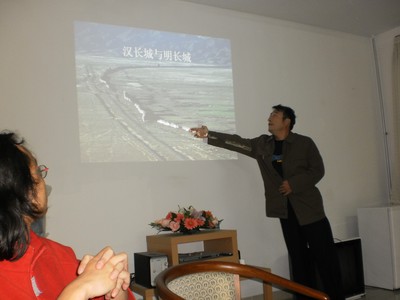Lecture about the great walls of China
Before we went to the Great Wall at Jinshanling, the PKU-Yale program had invited an enthusiast for the wall to show us his photos of it and talk about it. He spoke Chinese in Ningping interpreted ably. I thought it was a good lecture; he clearly knows history and he has travelled with his companion far and wide to photograph various sections of the wall. It was very interesting.

The same day, I finished reading the brilliant Paolo Squatriti's article "Digging Ditches in Early Medieval Europe" (Past and Present 2002). He argues with great conviction and drawing on the work of, among others, my colleague Jim Scott, that undertakings such as Offa's Dyke in Western England and the Danevirke in Southern Denmark had no practical value. He argues that rulers had these things constructed simply in order to show that they could, in other words, to demonstrate their power over the population, especially in marginal and newly conquered areas. Charlemagne's attempt at a canal between the rivers Main and Danube (well, stricly speaking their tributaries) is his most persuasive example: the undertaking was impossible, and it should have been obvious to Charlemagne that it was impossible, but he had recently conquered the surrounding area and needed to show that he was powerful. He does not seriously address the Great Wall of China, but he does say that the same reasoning applies to it (and refers to a book by Arthur Waldron that I must read). I really like the article, but I cannot help to think that it is not telling the entire story. While it is true that the Danish kings never could have had enough soldiers to man the Danevirke to make it into an efficient defense fortification, the same surely does not apply to the emperor of China, who could draw on a huge army. Also, Hadrian's wall in Northern England (which, curiously Squatriti does not mention, except once in passing) obviously was garrissoned with soldiers; there is sufficient archeological evidence for that, which I saw when I lived in Newcastle and visited the University museum. I need to think more about this, but I have a feeling that there is a part of the story that still escapes us.

The same day, I finished reading the brilliant Paolo Squatriti's article "Digging Ditches in Early Medieval Europe" (Past and Present 2002). He argues with great conviction and drawing on the work of, among others, my colleague Jim Scott, that undertakings such as Offa's Dyke in Western England and the Danevirke in Southern Denmark had no practical value. He argues that rulers had these things constructed simply in order to show that they could, in other words, to demonstrate their power over the population, especially in marginal and newly conquered areas. Charlemagne's attempt at a canal between the rivers Main and Danube (well, stricly speaking their tributaries) is his most persuasive example: the undertaking was impossible, and it should have been obvious to Charlemagne that it was impossible, but he had recently conquered the surrounding area and needed to show that he was powerful. He does not seriously address the Great Wall of China, but he does say that the same reasoning applies to it (and refers to a book by Arthur Waldron that I must read). I really like the article, but I cannot help to think that it is not telling the entire story. While it is true that the Danish kings never could have had enough soldiers to man the Danevirke to make it into an efficient defense fortification, the same surely does not apply to the emperor of China, who could draw on a huge army. Also, Hadrian's wall in Northern England (which, curiously Squatriti does not mention, except once in passing) obviously was garrissoned with soldiers; there is sufficient archeological evidence for that, which I saw when I lived in Newcastle and visited the University museum. I need to think more about this, but I have a feeling that there is a part of the story that still escapes us.
Kommentarer
Postat av: Eric
Perhaps the difference is between emperors behaving like emperors and building real large-scale defensive networks (the Great Wall, Hadrian's Wall) that were actually garrisoned, or intended to be; and local kings and warlords trying to behave like emperors by undertaking similarly large-scale projects, that nevertheless ended up being mostly symbolic.
Trackback
